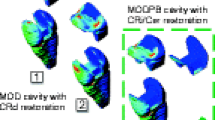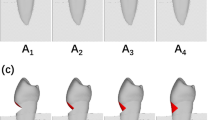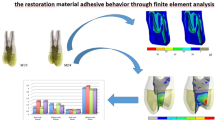Abstract
The aim of this study was to investigate the biomechanical interactions between cuspal preparation designs and cement thickness in a cusp-replacing ceramic premolar restoration. The cavity was designed in a typical MODP (mesial-occlusal-distal- palatal) restoration failure shape when the palatal cusp has been lost. Twelve 3D finite element (FE) models with four cavity preparations (without coverage and with buccal cuspal coverage in 1.0, 1.5 and 2.0 mm reducing in cuspal height) and three cement thicknesses (50, 100 and 150 μm) were constructed to perform the simulations. The results indicated that enamel and cement stresses in designs with no buccal cusp replacement or a 1.0 mm thick buccal cusp replacement were higher than the designs with 1.5 and 2.0 mm thick replacement. No apparent differences were found in the dentin, enamel, and cement stresses based on cement thicknesses of 50, 100, or 150 μm. This study concluded that when cusp replacement is indicated, reduction of the buccal cusp by 1.5 mm at least could reduce stress.







Similar content being viewed by others
References
Reeves GW, Lentz DL, O’Hava JW, McDaniel MD, Tobert WE (1992) Comparison of marginal adaptation between direct and indirect composites. Oper Dent 17:210–214
Ausiello P, Rengo S, Davidson CL, Watts DC (2004) Stress distributions in adhesively cemented ceramic and resin-composite Class II inlay restorations: a 3D-FEA study. Dent Mater 20:862–872. doi:10.1016/j.dental.2004.05.001
Al-Hiyasat AS, Saunders WP, Sharkey SW, Smith GM, Gilmour WH (1998) Investigation of human enamel wear against four dental ceramics and gold. J Dent 26:487–495. doi:10.1016/S0300-5712(97)00041-9
Chen HY, Hickel R, Setcos JC, Kunzelmann KH (1999) Effects of surface finish and fatigue testing on the fracture strength of CAD-CAM and pressed-ceramic crowns. J Prosthet Dent 82:468–475. doi:10.1016/S0022-3913(99)70036-3
Martin N, Jedynakiewicz NM (1999) Clinical performance of CEREC ceramic inlays: a systematic review. Dent Mater 15:54–61. doi:10.1016/S0109-5641(99)00014-7
Denissen H, Dozic A, van der Zel J, van Waas M (2000) Marginal fit and short-term clinical performance of porcelain-veneered CICERO, CEREC, and Procera onlays. J Prosthet Dent 84:506–513. doi:10.1067/mpr.2000.110258
Martin N, Jedynakiewicz NM (2000) Interface dimensions of CEREC-2 MOD inlays. Dent Mater 6:68–74. doi:10.1016/S0109-5641(99)00089-5
Modelli J, Steagall L, Ishikiriama A, de Lima Navarro MF, Soares FB (1980) Fracture strength of human teeth with cavity preparations. J Prosthet Dent 43:419–422. doi:10.1016/0022-3913(80)90213-9
Blaser PK, Lund MR, Cochran MA, Potter RH (1983) Effect of designs of class 2 preparations on resistance of teeth to fracture. Oper Dent 8:6–10
Khera SC, Goel VK, Chen RC, Gurusami SA (1991) Parameters of MOD cavity preparations: a 3-D FEM study, part II. Oper Dent 16:42–54
Toparli M, Gokay N, Aksoy T (1999) Analysis of a restored maxillary second premolar tooth by using three-dimensional finite element method. J Oral Rehabil 26:157–164. doi:10.1046/j.1365-2842.1999.00342.x
Lin CL, Chang CH, Ko CC (2001) Multifactorial analysis of an MOD-restored human premolar using auto-mesh finite element approach. J Oral Rehabil 28:576–585. doi:10.1046/j.1365-2842.2001.00721.x
Fennis WMM, Kuijs RH, Barink M, Kreulen CM, Verdonschot N, Creugers NHJ (2005) Can internal stresses explain the fracture resistance of cusp-replacing composite restorations? Eur J Oral Sci 113:443–448. doi:10.1111/j.1600-0722.2005.00233.x
Fennis WMM, Kuijs RH, Kreulen CM, Verdonschot N, Creugers NHJ (2004) Fatigue resistance of teeth restored with cuspal-coverage composite restorations. Int J Prosthodont 17:313–317
Kuijs RH, Fennis WMM, Kreulen CM, Roeters FJM, Burgersdijk RCW (2003) Fracture strength of cusp replacing resin composite restorations. Am J Dent 16:13–16
Lin CL, Chang YH, Chang WJ, Cheng MH (2006) Evaluation of a reinforced slot design for CEREC system to restore extensively compromised premolars. J Dent 34:221–229. doi:10.1016/j.jdent.2005.05.009
Romão W Jr, Miranda WG Jr, Cesar PF, Braga RR (2004) Correlation between microleakage and cement thickness in three Class II inlay ceramic systems. Oper Dent 29–2:212–218
Lim C, Ironside JG (1997) Grit blasting and the marginal accuracy of two ceramic venner systems-a pilot study. J Prosthet Dent 77:359–364. doi:10.1016/S0022-3913(97)70159-8
Audenino G, Bresciano ME, Bassi F, Carossa S (1999) In vitro evaluation of fit of adhesively luted ceramic inlays. Int J Prosthodont 12:342–347
Mou SH, Chai T, Wang JS, Shiau YY (2002) Influence of different convergence angles and tooth preparation heights on the internal adaptation of Cerec crowns. J Prosthet Dent 87:248–255. doi:10.1067/mpr.2002.122011
Leinfelder KF, Isenberg BP, Essig ME (1989) A new method for generating ceramic restorations: a CAD-CAM system. J Am Dent Assoc 118:703–707
Sjogren G (1995) Marginal and internal fit of four different types of ceramic inlays after luting. An in vitro study. Acta Odontol Scand 53:24–28. doi:10.3109/00016359509005940
Feilzer AJ, De Gee AJ, Davidson CL (1989) Increased wall-to-wall curing contraction in thin bonded resin layers. J Dent Res 68:48–50
Rees JS, Jacobsen PH (1992) Stresses generated by luting resins during cementation of composite and ceramic inlays. J Oral Rehabil 19:115–122. doi:10.1111/j.1365-2842.1992.tb01088.x
Hahn P, Attin T, Grofke M, Hellwig E (2001) Influence of resin cement viscosity on microleakage of ceramic inlays. Dent Mater 17:191–196. doi:10.1016/S0109-5641(00)00067-1
Ausiello P, Rengo S, Davidson CL, Watts DC (2004) Stress distributions in adhesively cemented ceramic and resin-composite Class II inlay restorations: a 3D-FEA study. Dent Mater 20:862–872. doi:10.1016/j.dental.2004.05.001
Lin CL, Wang JC, Kuo YC (2006) Numerical simulation on the biomechanical interactions of tooth/implant-supported system under various occlusal forces with rigid/non-rigid connections. J Biomech 39:453–463. doi:10.1016/j.jbiomech.2004.11.009
Boccaccio A, Prendergast PJ, Pappalettere C, Kelly DJ (2008) Tissue differentiation and bone regeneration in an osteotomized mandible: a computational analysis of the latency period. Med Biol Eng Comput 46(3):283–298. doi:10.1007/s11517-007-0247-1
Akca K, Cehreli MC (2006) Biomechanical consequences of progressive marginal bone loss around oral implants: a finite element stress analysis. Med Biol Eng Comput 44(7):527–535. doi:10.1007/s11517-006-0072-y
Maruyama T, Nakamura Y, Hayashi T, Kato K (2006) Computer-aided determination of occlusal contact points for dental 3-D CAD. Med Biol Eng Comput 44(5):445–450. doi:10.1007/s11517-006-0046-0
Lin CL, Chang CH, Cheng CS, Lee HE (1999) Three dimensional finite element meshing generation for maxillary second premolar. Comput Methods Programs Biomed 59:187–195. doi:10.1016/S0169-2607(99)00004-8
Lin CL, Lee HE, Wang CH, Chang KH (2003) Interfacial stress analysis between posterior resin-bonded bridge and abutments by finite element approach. Comput Methods Programs Biomed 72:55–64. doi:10.1016/S0169-2607(02)00116-5
Wheeler R (1974) Dental anatomy, physiology and occlusion. WB Saunders Co, Philadelphia
Goel VK, Khera SC, Gurusami S, Chen RC (1992) Effect of cavity depth on stresses in a restored tooth. J Prosthet Dent 67:174–183. doi:10.1016/0022-3913(92)90449-K
Farah JW, Craig RG, Meroueh KA (1989) Finite element analysis of three- and four- unit bridges. J Oral Rehabil 16:603–611. doi:10.1111/j.1365-2842.1989.tb01384.x
Benzing UR, Gall H, Weber H (1995) Biomechanical aspects of two different implant-prosthetic concepts for edentulous maxillae. Int J Oral Maxillofac Implants 10:188–198
Fischer H, Dautzenberg G, Marx R (2001) Nondestructive estimation of the strength of dental ceramic materials. Dent Mater 17:289–295. doi:10.1016/S0109-5641(00)00086-5
Kelly JR, Tesk JA, Sorensen JA (1995) Failure of all-ceramic fixed partial dentures in vitro and in vivo: analysis and modeling. J Dent Res 74:1253–1258
Hannig C, Westphal C, Becker K, Attin T (2005) Fracture resistance of endodontically treated maxillary premolars restored with CAD/CAM ceramic inlays. J Prosthet Dent 94:342–349. doi:10.1016/j.prosdent.2005.08.004
Van Meerbeek B, Inokoshi S, Willems G, Noack MJ, Braem M, Lambrechts P et al (1992) Marginal adaptation of four tooth-coloured inlay systems in vivo. J Dent 20:18–26. doi:10.1016/0300-5712(92)90004-V
Schmalz G, Federlin M, Reich E (1995) Effect of dimension of luting space and luting composite on marginal adaptation of a class II ceramic inlay. J Prosthet Dent 73:392–399. doi:10.1016/S0022-3913(05)80337-3
Provatidis CG (2000) A comparative FEM-study of tooth mobility using isotropic and anisotropic models of the periodontal ligament. Finite element method. Med Eng Phys 22:359–370. doi:10.1016/S1350-4533(00)00055-2
Toms SR, Dakin GJ, Lemons JE, Eberhardt AW (2002) Quasi-linear viscoelastic behavior of the human periodontal ligament. J Biomech 35:1411–1415. doi:10.1016/S0021-9290(02)00166-5
Yoshida N, Koga Y, Peng CL, Tanaka E, Kobayashi K (2001) In vivo measurement of the elastic modulus of the human periodontal ligament. Med Eng Phys 23:567–572. doi:10.1016/S1350-4533(01)00073-X
Author information
Authors and Affiliations
Corresponding author
Rights and permissions
About this article
Cite this article
Chang, YH., Lin, WH., Kuo, WC. et al. Mechanical interactions of cuspal-coverage designs and cement thickness in a cusp-replacing ceramic premolar restoration: a finite element study. Med Biol Eng Comput 47, 367–374 (2009). https://doi.org/10.1007/s11517-008-0379-y
Received:
Accepted:
Published:
Issue Date:
DOI: https://doi.org/10.1007/s11517-008-0379-y




